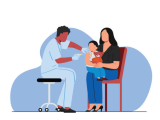Jan 14, 2003 (CIDRAP News) – The Association of State and Territorial Health Officials (ASTHO) says the present is an excellent time for states to prepare for the next influenza pandemic and has issued a report to help show the way.
Although 47 states are working on or have completed draft plans for coping with a "flu" pandemic, the United States is not prepared for a event like the 1918 Spanish flu, which killed at least 550,000 Americans, according to the ASTHO document.
Now is the right time to prepare, because a pandemic is inevitable and because federal grants for public health infrastructure and planning have greatly increased in response to terrorism worries, according to ASTHO. The group's recently published report is titled "Preparedness Planning for State Health Officials: Nature's Terrorist Attack: Pandemic Influenza."
The report says an influenza pandemic may cause far more harm than a bioterrorist attack: an estimated 89,000 to 207,000 deaths, 314,000 to 734,000 hospitalizations, 18 million to 42 million medical visits, and 20 million to 47 million additional illness cases. State health officers must take the lead in planning because, in a pandemic, the public, governor, and legislature will look to them for "significant leadership to mobilize and sustain private and public healthcare resources."
The public health resources needed to cope with bioterrorism overlap substantially with those needed to deal with a flu pandemic, the report states. "The overlap demonstrates why state health officials have an unprecedented opportunity, using their bioterrorism assessments and plans as scaffolding, to help create strategies that will improve their states' response to future pandemics."
Pandemics occur when a wholly new subtype of influenza A virus emerges, the document explains. "There is no way to predict when the next pandemic will occur, but most experts agree that it will happen." After the 1918 Spanish flu, pandemics occurred in 1957 and 1968, causing a total of 104,000 deaths.
When a pandemic comes, it will probably bring two waves of cases, separated by between 3 and 9 months, the report says. Thus health officials should be prepared for a pandemic period lasting longer than a year.
The United States has a National Pandemic Influenza Plan prepared by agencies in the Department of Health and Human Services, the report says, but ASTHO does not comment on the adequacy of that plan. In addition, 12 states have completed draft preparedness plans, and another 35 states are working on such plans, ASTHO reports. Some public health experts say those plans identify the major issues in a pandemic but don't spell out specific steps for responding to such an event, says the report.
The likelihood of vaccine shortages is a key reason for each state to have its own plan, according to ASTHO. Because it will take an estimated 6 to 8 months to produce an effective vaccine, there will probably be severe shortages or even a total lack of vaccine in the early stages of a pandemic.
Consequently, "There is a need to identify priority groups (i.e. high risk individuals, health care workers, law enforcement) that should first receive the influenza vaccine," the document says. "Although this has been discussed at the national level, there is no definitive guidance that identifies the priority groups. The CDC Pandemic Influenza Planning Guide for State and Local Officials offers a default list for use in planning activities until decisions are finalized."
The report notes that states may want to link their pandemic flu vaccination plans with their smallpox vaccination plans, which were developed after the Centers for Disease Control and Prevention (CDC) issued guidelines last September.
Other issues discussed in the document include the use of antiviral drugs, quarantine and containment, laboratory protocols, provider and workforce shortages, use of volunteers, facility and equipment needs, and communication with the public. The report includes detailed checklists regarding legal and policy issues, authority, vaccination/antivirals, surge capacity; communications and education, and laboratory surveillance.
The ASTHO report was funded by the CDC and researched and written by Lara Misegades, MS, ASTHO's senior analyst for infectious disease policy.
See also:
Full text of report on the ASTHO site
http://www.astho.org/Programs/Infectious-Disease/Emerging-Infectious-Diseases/Pan-ASTHO-Pandemic-Influenza-2002/


















